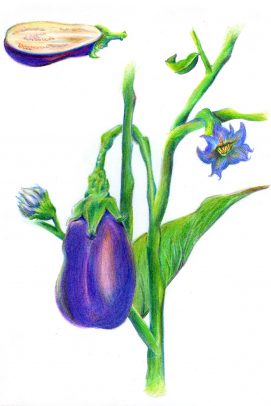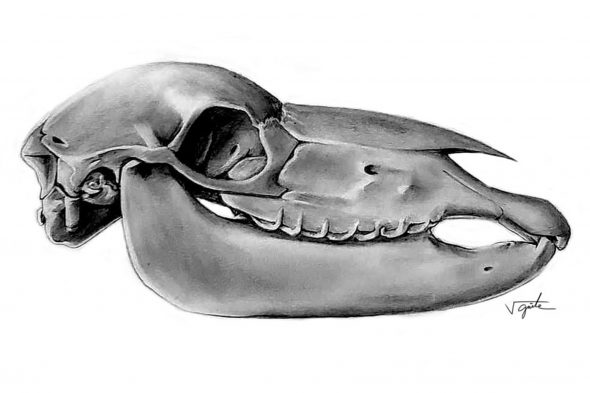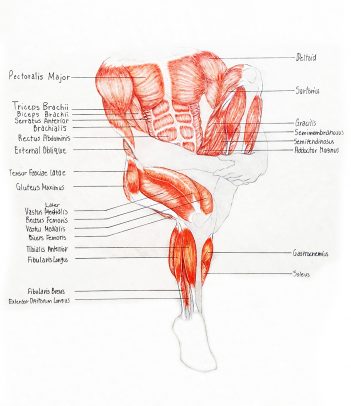Art, science come together in UIC minor

Alexandra Mangam’s illustration of an eggplant
Undergraduate students at the University of Illinois at Chicago are studying life science visualization, or Life Sci Viz, thanks to a minor launched last year by the College of Applied Health Sciences. The new minor brings together biological and physical sciences, engineering, art and health care fields to teach students how to visualize science.
While the college’s Biomedical Visualization Graduate Program — one of only four accredited medical illustration programs in North America — was established nearly 100 years ago, the minor launched just one year ago in January 2019. UIC’s Samantha Bond is overseeing the minor, which she said was developed to meet student demand.
“It was heartbreaking to see how often undergraduate students felt they had to pick between the arts and the sciences,” said Bond, clinical assistant professor of biomedical and health information sciences and physical therapy. “We developed this program so that students from any discipline can learn the skills needed to collaborate with others and to produce accurate, eye-catching creative work that represents topics in science.”
The courses for the Life Sci Viz minor are open to any student as long as prerequisites are met.
Three Life Sci Viz students share how the Life Sci Viz minor helped them refined their career goals:
Alexandra Mangam, senior in biological science in the College of Liberal Arts and Sciences
“Quite honestly, for me, the thought of working in a research lab, pipetting for the rest of my life, was scary. Not everyone is meant for research, and I didn’t feel prepared for the future,” Mangam said.
“During my freshmen year, my mentor was an anaplastologist that constructed facial prosthetics for patients. She integrated a lot of fine arts into her job – hand-painting layers of skin, veins and capillaries on prostheses to exactly match how they look on the patient. I thought it was really cool.
“When UIC introduced the Life Sci Viz minor program, I had to try it. It was so interesting learning the art side. I was always very visual with my learning so, in retrospect, it now seems natural to gravitate towards a biomedical visualization career.
“I have finished the minor and am still taking classes because I love it. I’ve grown as an artist, a scientist and as a person. I have a future that I’m looking forward to.”

Victoria Venice Goite, sophomore in fine arts in the College of Architecture, Design, and the Arts
“Many people in my family have a medical background and I was heavily influenced by them,” Goite said. “In my culture, I believe there is this pressure to pursue scientific fields. I feel that people who are actually passionate about art are afraid to show that side. As much as I was interested in science, I loved art and believed in making my own path. So, I took as many AP art classes in high school to advance my artistic skills. Still, I wanted to combine art and science so I researched this Life Sci Viz minor.
“People don’t realize that art itself is not just painting, sitting and drawing. It’s about visualization and making something minuscule in your life, like a leaf, and giving it life through your eyes. Science heavily relies on observations and explanations — if you want to explain your findings, put figures in a textbook or even give an informational pamphlet to patients, you have to put creative thought into what you’re doing.
“The Life Sci Viz minor is providing me a solid foundation in both art and science. It gives me the security that I won’t have to choose between earning money and being a creative person. If you are passionate about art and science and haven’t found that middle ground, this is a great place to go.”

Bendita Qian’s visualization of human musculature
Bendita Qian, senior in integrated health studies in the College of Liberal Arts and Sciences
“When I came to UIC, I was a pre-med undeclared major and I was struggling in the science classes,” Qian said. “Those classes didn’t interest me. So, I decided to major in integrated health, which also incorporates the social sciences. Then UIC came out with the Life Sci Viz minor and I found it interesting because it would give me the opportunity to do something science-related that still integrated the arts.
“Art is an excellent form of communication and is a very good bridge for scientists to convey the information that they research and discover. If you have an artist serve as the middle ground, they can disseminate it in a way people can understand it and feel comfortable reading it. This could also help reduce the stigma of arts being a lower status than science and technology fields.”
“This minor really allows students to experience something holistic. Students learn to approach the sciences or arts from a different perspective. In a number of scientific fields, many factors in the arts, creativity and communication are vital in conducting meaningful research. Because we have so much accessible content in the world now, it can overwhelm people with cognitive burden. It’s more important than ever as illustrators to create work that is beautiful, accurate and easy to understand. In the process, I believe our contributions will validate the inclusion of art in the process of impactful scientific discovery.”
Categories
Health Sciences Colleges, Students
Topics
Applied Health Sciences, art, biomedical visualization, minor, science, students
